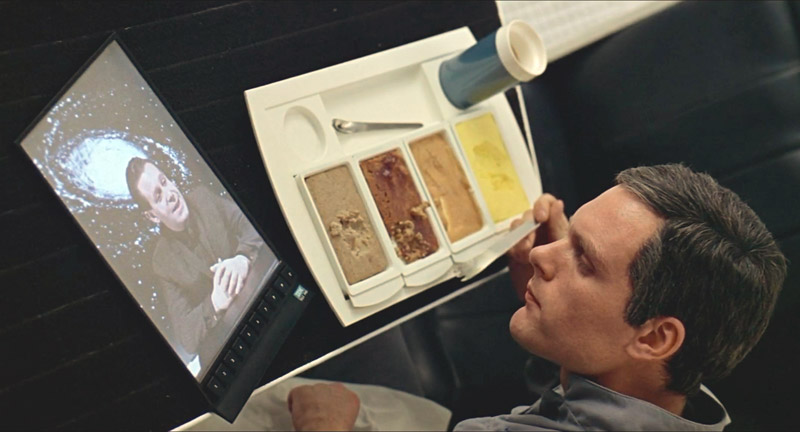Stanley Kubrick and Arthur C. Clarke's cinematic masterpiece, 2001: A Space Odyssey, remains incredibly impactful for its uncanny foresight and its masterful navigation between scientific accuracy and artistic necessity. Watching it decades after its release, it's striking to see how many of its visions became reality.
From Prophecy to Reality: The Flat-Screen Tablets
One of the film's most memorable and prescient technological predictions was the "Newspad"—a thin, portable screen used by astronauts David Bowman and Frank Poole during their meals aboard Discovery One. In the 1960s, with computers being clunky behemoths, the idea of casually interacting with a sleek, touch-interface device for news and entertainment was pure science fiction. Yet, today, these "Newspads" are our ubiquitous iPads, Android tablets, and e-readers, a testament to Clarke's scientific imagination and Kubrick's visual realization.
The Gravity Question: How Big is Big Enough?
Beyond the portable screens, 2001 famously brought the concept of artificial gravity to the big screen. The film features two prominent rotating structures: the large Space Station V, where Heywood Floyd makes his video call, and the internal centrifuge of the deep-space vessel, Discovery One. The film showed characters moving with apparent Earth-like ease within these spinning environments, prompting questions about their scientific feasibility.
Space Station V: Spinning Toward Credibility
This orbital station—where Dr. Heywood Floyd makes a video call to Earth—has a diameter of roughly 300 meters and spins slowly at about 1 RPM. By today’s understanding, that would produce about one-sixth of Earth’s gravity (comparable to lunar gravity).
While not a full 1g, it’s enough to mitigate the disorienting effects of weightlessness, and—crucially—would reduce the Coriolis effect, which can cause nausea and balance issues in faster-spinning, smaller habitats. With its generous radius and gentle spin, Space Station V holds up well as a scientifically plausible environment for long-term habitation—though in reality, people would move more like they do on the Moon, with a light, bounding step rather than the steady Earth-like stride shown in the film.
Discovery One's Centrifuge: Small Scale, Big Leap
This was where the film took significant artistic license. At only 11.6 meters in diameter (5.8-meter radius), to generate anything close to Earth-like gravity, this section would have to spin at an impossibly high rate (over 12 RPM for 1g). At such speeds, the Coriolis effect would be overwhelming, rendering it unusable for human comfort or even basic movement. The film depicted astronauts moving with Earth-like ease, a practical necessity for storytelling and set design.
The Art of the Plausible: Scientific Reality Meets Cinematic Vision
So, did Clarke and Kubrick know these discrepancies? Absolutely. Arthur C. Clarke, a scientist himself, was well-versed in the physics of artificial gravity. Kubrick, with his meticulous research and reliance on scientific consultants, also understood the ideal dimensions. The choices made were a deliberate balance:
- To maintain believability: The concept of spin gravity was crucial for depicting long-duration space travel.
- To achieve cinematic impact: Building a 900-meter radius set (for 1g) in the 1960s was simply impossible. The film had to work within the practical limits of special effects and budget.
- To prioritize storytelling: The seamless movement of the astronauts was essential to the narrative and visual flow, rather than showing them constantly nauseous or awkwardly floating.
The film's enduring believability, despite these scientific compromises, stems from Kubrick's unparalleled visual consistency, the groundbreaking special effects, and a compelling internal logic that convinced audiences this future felt "right."
Remastering Reality: A Future for Classic Cinema?
This leads to a fascinating thought: could modern CGI and AI allow for "remixes" of classic films like 2001? Imagine a version where Space Station V and Discovery One's centrifuge are digitally re-rendered to their scientifically accurate dimensions for comfortable 1g, with the original actors seamlessly composited into these newly scaled environments.
With advancements in CGI, AI-driven scene reconstruction, and sophisticated digital compositing, such projects are becoming increasingly plausible. This could offer new ways to experience beloved classics, perhaps even creating "scientifically accurate cuts" alongside the original artistic visions. While challenging due to cost, effort, and the fundamental question of altering a director's original intent, the technological capability for such re-imaginings is rapidly emerging, potentially opening a new frontier for film preservation and reimagining.
2001: A Space Odyssey remains a testament to visionaries who dared to dream of the future, understanding that sometimes, a touch of artistic license is necessary to bring complex scientific ideas to life in a way that truly captivates the human imagination.



.png)


Comments